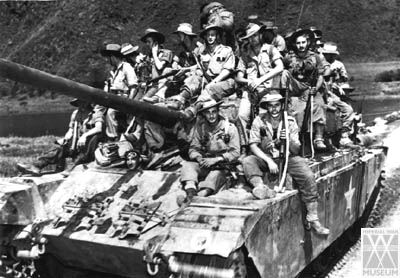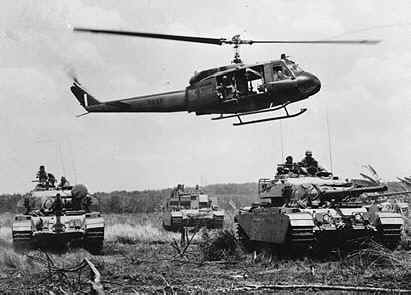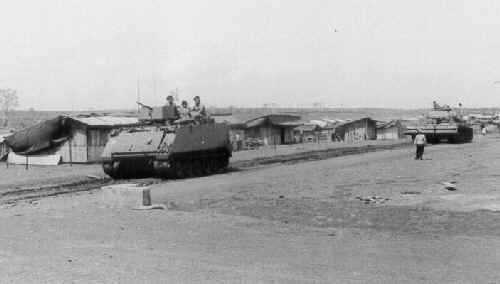 |
|
|||
|
|
||||
|
|
| A Centurion Mk 5/1 Main Battle Tank with the serial number 169110 on the front of the vehicle. The vehicle shows damage to the hull near the right hand exhaust shroud possibly sustained in active service. Summary: This tank was used by A Squadron 1st Armoured Regiment in operational duties in Vietnam. On 18 February 1970 this tank sustained 3 rocket propelled grenade (RPG) strikes during Operation Hamersley. Records show it was hit in the right hand exhaust shroud, right hand rear track bin and left hand track guard, but still remained battle-worthy. The vehicle shows evidence of damage to the hull near the right hand exhaust shroud which is possibly related to the RPG strikes it sustained. The Centurion Mk 5/1 Main Battle Tanks were initially Mk III tanks which were later modified to Mk V/I and served in the Australian Army from 1952 until 1977. This Centurion Mk 5/1 Main Battle Tank has been on display in ANZAC Hall since 2001. |
|
Australian Infantry hitch a lift on a British Centurion tank, Korea, June 1951 IWM KOR 648 |
 |
|
|
The Centurion was Britain's first attempt to produce a universal tank and do away with divisions between Infantry Tanks (e.g. Matilda) and Cruiser Tanks | ||
| History
In 1943, after a succession of unfortunate tank designs the British War Office commissioned a new specification calling for a tank with durability, reliability, a weight of 40 tons and the ability to withstand a direct hit from the German 88mm gun. Six prototypes were developed before the end of World War 2, but arrived to late to take part in the war on German soil. It was soon recognised that the weight restrictions had to be lifted as the original specification could not be achieved within the 40 ton weight limitation.
The early vehicles were equipped with a 17 pounder main gun and a 20mm Polsten cannon. They also featured frontal, glacis plate armour to deflect shot, a partially cast turret and Horstmann suspension. However, modifications to the original design were quickly made and the changes resulted in the adoption of a 20 pounder, fully stabilised, main gun and the replacement of the 20 mm cannon by a Besa mg (thus allowing the turret to be fully cast). These changes resulted in the Mk 3 version of the vehicle. NB: It was reputed that the performance of the 20 pounder gun (when firing APDS) was twice that of the 88mm gun of the German, Royal Tiger Tank. In order to maintain its combat effectiveness, continuing modifications have led to numerous changes to main gun armament (e.g. 105 mm), fire control equipment, infra-red driving aids, engines (particularly diesels) and semi-automatic transmissions. The Centurion was Britain's first attempt to produce a universal tank and do away with divisions between Infantry Tanks (e.g. Matilda) and Cruiser Tanks (e.g. Covenanter). The original design was rapidly changed in the light of performance reports and led to the production of the Mk 2. Further modifications resulted in the production of the Mk 3. This mark introduced the 20 pounder gun and the fully cast turret, plus a number of engine modifications. In this form, the Centurion first saw action in Korea in 1951 and soon proved itself to be the best performing tank in this theatre of operations. Particularly notable was its excellent cross country performance. In operations around the Imjin River in Korea, two Centurions had to be hastily abandoned and to prevent them from falling into enemy hands it became necessary to destroy them. Despite being pounded by armour-piercing shot from a range of 50 m. neither tank caught fire and both were subsequently recovered and repaired. Constant modifications and upgradings enabled the Centurion to remain at the fore-front of tank technology. The design of the vehicle was such that it could easily be up-gunned and re-engined and it was to later prove itself in numerous tank engagements in the Middle-East and India. Australian Service History The first purchaser of the Centurion was Australian Army in 1950, however the initial consignment was transferred to the 8th King's Royal Regiment, Irish Hussars at the outbreak of the Korean War. This Regiment was re-equipped with the Centurion and was employed to support the Commonwealth contingent fighting with the United Nations forces. It was not until February 1952 that Centurions arrived in Australia where they entered service with 1st Armoured Regiment. The tanks were off-loaded at Sydney and delivered by train to Puckapunyal, Victoria. (NB: The Archives Section, State Rail Authority, NSW possesses an excellent photographic collection showing the off-loading and trans-shipment of these vehicles to Puckapunyal. These photographs are available for examination and copies may be purchased from the Archives Section). The Australian Centurions were Mk. 3's and these were equipped with 20 pounder guns and the 7.92 Besa mg's were replaced with .30 cal. Browning mg's. The tank training area around Puckapunyal proved a severe testing ground for the Centurion, in particular its suspension system, yet it proved to be a most robust vehicle. With the growing commitment to the Vietnam War in the 1960's, a number of Centurions were modified in 1967 at 3rd Base Workshops, Bandiana, Victoria for employment with the 1st. Australian Task Force serving in Phuoc Tuy Province. The tanks were modified to Mk. s/i (Australian) standard by the addition of applique armour on the glacis plate, .50 cal. ranging gun, No 4 RCP sight and infra-red night fighting equipment for the commander, gunner and driver. In February 1968, C Squadron of 1st. Armoured Regiment, reinforced by a Special Equipment Troop of bridge-layers and tank-dozers and integral to the RAEME (Royal Australian Electrical and Mechanical Engineers) support, was committed to enhance the combined arms nature of the Task Force. Such was the effectiveness of this armoured combat team, that many repairs, including major tasks, were performed in the field. This practice astounded a number of American Units which were content to recover vehicles to rear maintenance areas or to simply write-off battle damaged vehicles. Despite considerable scepticism of many observers and senior Army personnel, the Centurion proved particularly effective at fighting in the paddy-fields and jungle areas of Vietnam. They proved their worth on many occasions, notably in the defence of Fire Support Bases Coral' and Balmoral', during the Tet offensive of 1968, in fighting around Binh Ba and in a number of offensive operations in Phuoc Tuy Province. (NB: A good account of the Centurions involvement in Vietnam is provided in the book, "The Battle of Coral" by Lex McAuley). By 1971, when the tanks were finally withdrawn, all three Squadrons of 1st. Armoured Regiment had served in South Vietnam, with C Squadron having served twice. During 1955 the 1/15 RNSWL was introduced to the Centurion Tank and these were later to become its main fighting equipment. By 1965 a home training tank was taken on charge at Lancer Barracks and given the name Assegai. A further tank was received later and by 1968 three tanks were located at the Barracks. Prior to the delivery of these vehicles, all training and instruction was conducted at the Armoured Centre, Puckapunyal. The Regiment was involved in infantry/tank cooperation training with the 5th and 7th Battalions, Royal Australian Regiment prior to their departure to Vietnam. In 1971, the role of the Regiment was changed the that of a Cavalry Regiment and was re-equipped with M113A1 Armoured Personnel Carriers. The Centurions were phased out of service at that time. In all, the Australian Army purchased 131 Centurions including six ARV's Mk. 2, four Bridge-layers and four Tank-dozers. An interesting conversion undertaken by the Armoured Centre, Puckapunyal was the Driver Training Tank, this was achieved by removing the turrets from conventional tanks and fitting a lightweight enclosed structure fitted with a number of seats for trainee drivers. The Centurion was eventually phased out of military service in 1977. This section is based on http://www.lancers.org.au/museum/Centurion.htm with other photos and details added.
|
|||
|
Australian Armour in South Vietnam
An M113A1 leads a Centurion Mark 5/1(Aust) Dozer through a village in South Vietnam during 1968. Both vehicles are operated by C Squadron 1st Armoured Regiment, which deployed to South Vietnam in February of that year. The M113A1 is either ARN 134151 or 134174, and the Dozer is either ARN 169079 or 169106, the latter having the distinction of firing the Regiment's first 20pdr main armament round in combat in South Vietnam. Witnesses stated that it wounded a chicken! Nevertheless, the various Squadrons of 1st Armoured Regiment that served in South Vietnam between February 1968 and September 1971 acquitted themselves well. They were involved in some notable actions, including the defence of Fire Support Bases Coral and Balmoral in 1968, and the Battle of Binh Ba in June 1969. In all, 58 Centurion tanks, including three Bridge-layers and four Armoured Recovery Vehicles, saw service in South Vietnam. At least six vehicles (but possibly seven) served two tours of duty. Two Centurion crewmen were killed while on operations. Tpr Michael Hannaford was driving ARN 169017 in December 1968 when it detonated a small mine, blowing the drain plug into the driving compartment and fatally wounding Tpr Hannaford. In May 1969, Tpr James Kerr was killed instantly when the tank he was driving, ARN 169005, detonated a large mine which blew the floor out of the driving compartment. |




